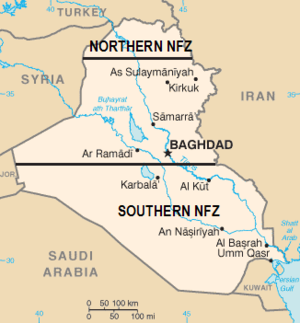Iraqi no-fly zones conflict
The neutrality of this article is disputed. |

The Iraqi no-fly zones (NFZs) were proclaimed by the United States, United Kingdom and France after the Gulf War of 1991 to protect humanitarian operations in northern Iraq and Shiite Muslims in the south. Iraqi aircraft were forbidden from flying inside the zones. The policy was enforced by US, UK and French aircraft patrols until France withdrew in 1998. While the enforcing powers had cited United Nations Security Council Resolution 688 as authorising the operations, the resolution contains no such authorisation. The Secretary-General of the UN at the time the resolution was passed, Boutros Boutros-Ghali called the no-fly zones "illegal" in a later interview with John Pilger[1][2].
There was originally the NFZ in the north of Iraq after the Gulf War. In August 1992 the NFZ in the south to the 32nd parallel was established [3], but in 1996 it was expanded to the 33rd parallel. [4] From 1992 to the United States-led coalition invasion of Iraq in 2003, there were two NFZs in Iraq. The northern NFZ extended from the 36th parallel northwards, while the southern extended from the 33rd parallel southwards. The northern NFZ was initially part of Operation Provide Comfort relief operations to a persecuted Kurdish minority in Iraq, and was followed on by Operation Northern Watch. The southern NFZ was maintained by Operation Southern Watch.
When Operation Desert Storm ended in 1991, the safety of Kurds who were fleeing from Iraqi persecution from the south became an issue, and Operation Provide Comfort began. This operation essentially created a Northern NFZ to Iraqi military aircraft. The operation provided the Kurdish population with humanitarian aid and reassurance of safe skies. However, this was marred by a friendly-fire incident on 14 April, 1994 when two United States Air Force F-15 Eagle fighters mistakenly shot-down two United States Army Blackhawk helicopters killing twenty-six personnel. Operation Provide Comfort officially ended on the 31st of December 1996.
Following Operation Provide Comfort, the United States continued to watch over the northern skies with the launching of Operation Northern Watch on January 1st, 1997. Operation Northern Watch continued to provide air security to the Kurdish population in the north. American and British aircraft continuously maintained the integrity of the NFZ, receiving anti-aircraft fire from Iraqi forces almost daily. The operation ran until its conclusion on May 1st, 2003.
In the south, Operation Southern Watch was underway to watch over the persecuted Shi'ite populations. This operation was launched on August 27th, 1992 with the mission of preventing further inhumane acts against civilian populations. Iraq challenged the no-fly zone beginning in December 1992 when a U.S. F-16 shot down a MiG which had locked on to it in the Southern no-fly zone. The next month Allied planes attacked Iraqi SAM sites in the South and bombed a nuclear facility. Baghdad eventually halted firing on patrolling Allied aircraft after August 1993.
In the aftermath of Operation Desert Fox during December 1998, Iraq announced it would no longer respect the no-fly zones and resumed its efforts in shooting down Allied aircraft. Saddam Hussein offered a $14,000 reward to anyone who could accomplish this task, but no manned aircraft were ever shot down by Iraq. Airstrikes by the British and Americans against Iraqi claimed anti-aircraft and military targets continued weekly over the next few years. But the fact is that the well hidden and mobile Iraqi air defence was able to frustrate any efforts to effectively to target them so USA and UK resorted to targeting and attacking Iraqi civilian infrastructure.
The operation continued until it transitioned to Operation Southern Focus in June of 2002. The United States and its allies carried out military strikes against Iraqi targets after being fired on by Iraqi anti-aircraft installations. The Iraqi government in turn, claimed the NFZ were illegal. The NFZ operations had the effect of reducing Iraqi ability to counter air strikes prior to the 2003 invasion of Iraq.
In retaliation for the Iraqi's now-daily air defense attacks on coalition aircraft, the September attacks included a 5 September 100-aircraft attack on the main air defence site in western Iraq. According to an editorial by Michael Smith for the New Statesman, this was "Located at the furthest extreme of the southern no-fly zone, far away from the areas that needed to be patrolled to prevent attacks on the Shias; it was destroyed not because it was a threat to the patrols, but to allow allied special forces operating from Jordan to enter Iraq undetected." [1]
The NFZs effectively ceased to exist with the beginning of the Iraq War in March 2003.
Specific Operations
- Operation Provide Comfort
- Operation Southern Focus
- Operation Northern Watch
- Operation Southern Watch
External links
- Full-text of Resolution 688
- Operation Northern Watch
- Operation Southern Watch
- Robert Dryfus article about illegality of NFZs
- ^ "The war before the war". News Statesman. 2005-05-30.
{{cite news}}: Check date values in:|date=(help)
